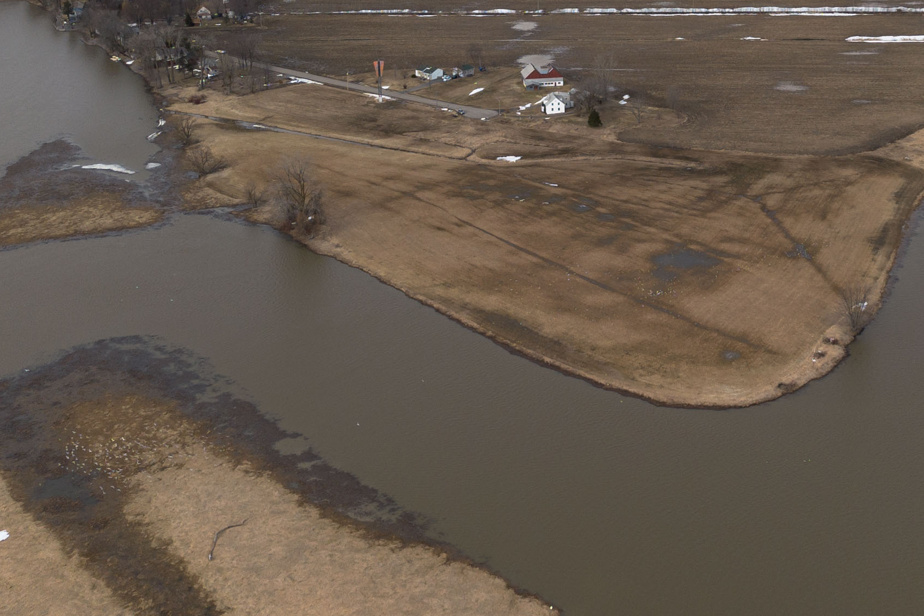The new flood zone maps which will be revealed in 2025 are already causing concern among several mayors in the province. This means that 77,000 homes could be affected by the new regulations, three times more than currently, Quebec announced on Tuesday.
“The first thing citizens will ask us is ‘am I in this area?’. And unfortunately, we have no concrete answer to give them,” laments François Robillard, mayor of Sainte-Marthe-sur-le-Lac. The rupture of his city’s dike forced the evacuation of 6,000 people in 2019. “Imagine the full weight of the uncertainty these citizens are currently facing, with this announcement today,” he added .
The Minister of the Environment, the Fight against Climate Change, Wildlife and Parks, Benoit Charette, announced earlier today the update of the regulatory framework concerning flood zones. More specifically, new flood zone maps will be unveiled in the coming months: they will draw on scientific knowledge to predict overflows and river movements induced by climate change. They will be carried out in collaboration with municipalities, and should gradually be made public until spring 2025.
“This is probably the most important gesture of adaptation to climate change that the Quebec government is taking through the announcement made today,” said Benoit Charette during a press briefing on this subject.
“We have collectively experienced several tragedies related to flooding. Let us always remember that the goal is to prevent this from happening again in the future,” also declared Martin Damphousse, president of the Union des municipalités du Québec and mayor of Varennes.
However, the minister did not specify where the 55,000 additional homes which will find themselves in a flood zone are located when they were not previously. “We can’t give an exact number without the maps being updated,” he said, but “there won’t be many surprises.” For example, “a person who is currently not in a flood zone, but who was flooded in 2017 or 2019, that person must expect that the status of their property will change,” he said. added.
The Montreal Metropolitan Community (CMM) sent preliminary maps of flood zones on their territories to the mayors of Greater Montreal last week. But one point remains unclear: the status of houses located near a dike, in a so-called “precautionary” zone, which could find themselves flooded if it gives way. We currently consider that they remain in a flood zone within a radius of 100 meters, but this could be reduced to 10. “For these towns, the number of citizens concerned can range from around twenty to a thousand.” , underlines Nicolas Milot, director of ecological transition and innovation at the CMM.
If the new regulation is applied as is, according to the CMM maps, “96% of our residents are currently in a flood zone,” says Sonia Fontaine, the mayor of Pointe-Calumet, in the Laurentians. “We wake up one morning, like that, with the values of our houses going down, the mortgage uncertainty, the insurance uncertainty…” she lists. In his town, only about 20 homes were affected in previous floods, or less than 1% of residences.
She emphasizes that the municipality has been carrying out work for several months to ensure that residences are better protected against the risk of flooding. “We have been living with the damming works for 48 months. More than 30 million which were granted by the government, and today they are not considered. This is nonsense,” she blurted.
Same story with Alain Goyette, mayor of La Visitation-de-l’Île-Dupas, in Lanaudière. In his city, several homes have been designated as being in a flood zone since a provisional version of the new by-law was put in place on March 1, 2022. “There are people who are declared as being in a flood zone of exaggerated and erroneous way,” he says. “The citizens are trapped. It disrupts retirement plans, it deprives seniors or people with disabilities of being able to furnish their homes. »
The new mapping will define the risk of flooding (from low to very high) according to two criteria: the probability that a flood could occur in the coming years on the one hand, and the height that the water level could reach. somewhere else. A home that has a greater than 70% chance of experiencing flooding in the next 25 years, for a water level reaching 30 cm or more, will for example be in a “very high” flood risk zone.
Concerning the concerns of citizens located in flood zones about the increase in their mortgage loan and their insurance premium, “the modernization of the regulatory framework will not fundamentally change the situation”, assured Jean during the press briefing. -François Constant, director of water policies at the ministry. “We are not insurers […], but we have not heard of any emerging trends in relation to changes in practices,” he said.
This announcement will be followed by a 90-day consultation period, in which citizens and municipalities are invited to participate.




